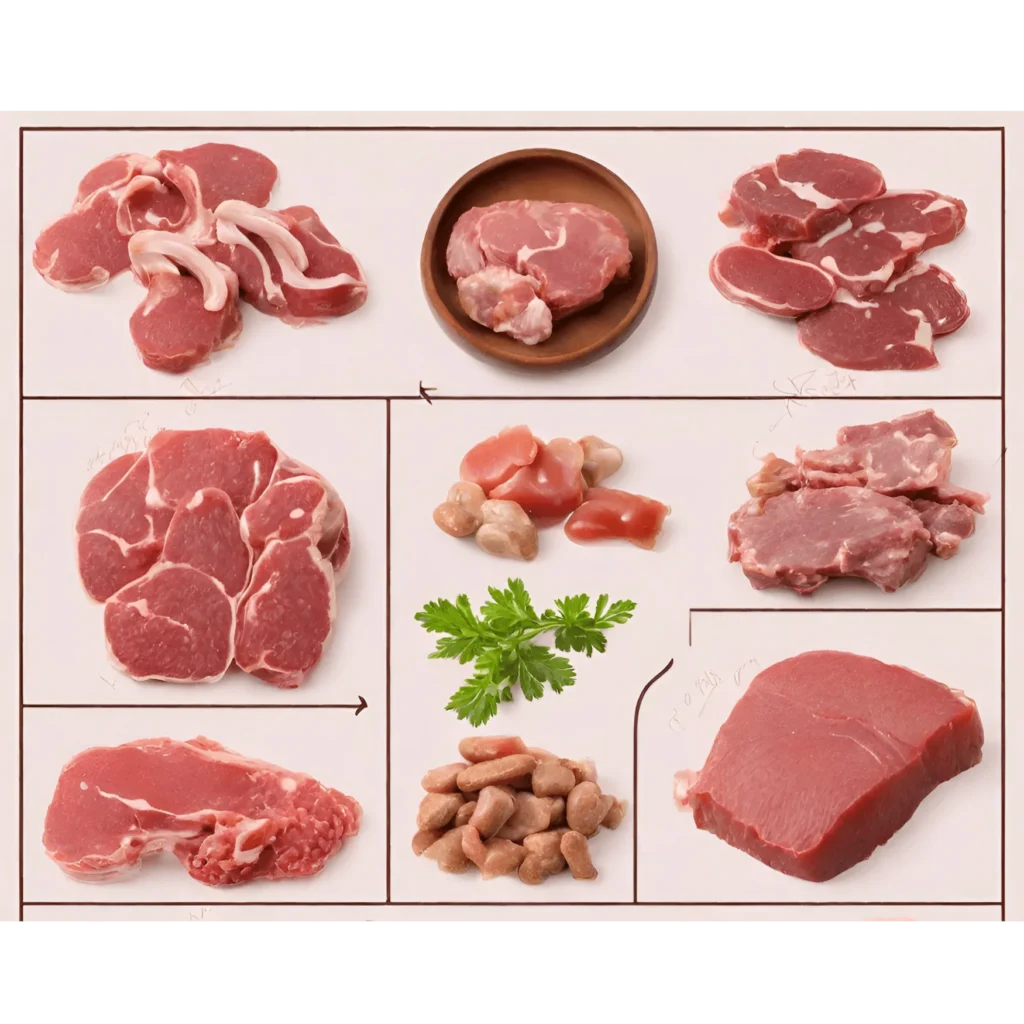Organ meats can work wonders for a dog’s health. They are crucial additions to a dog’s diet, packed with essential nutrients vital for overall health, including protein, vitamins, minerals, and essential fatty acids.
They are greatly beneficial to a dog’s health. They can help boost the dog’s immune system, improve digestion, and support overall health.
In this article, we will cover everything about feeding organ meat to your dog. Here are the points we are going to discuss:
- What Are Organ Meats?
- Benefits of Organ Meats for Dogs
- Different Types of Organ Meat
- How Much Organ Meat Should Dogs Eat?
- How to Safely Feed Organ Meats to Dogs?
- Recipes of organ meat for dogs
What Are Organ Meats?
Organ meat for dogs refers to the internal organs of animals like sheep or cattle. Additionally, gizzards, hearts, and livers of ducks, chickens, and turkeys are also some of the organs that you can feed to your dog. These organs play an important role in a dog’s diet because they are rich in nutrients essential for a dog’s health.

Benefits of Organ Meats for Dogs:
Organ meat contains many health benefits for dogs. It provides essential nutrients for their well-being, including protein, vitamins, minerals, and essential fatty acids.
Protein:
Protein is essential for dog health. It supplies amino acids to the body, which aid in building and repairing tissues like hair, skin, and muscles. It also helps in the production of enzymes and hormones, and in oxygen transportation. Dogs can obtain high-quality protein from organ meats, which are easy to digest.
Vitamins:
Organ meats contain a variety of vitamins that are important for dogs’ health. These include fat-soluble vitamins such as A, D, E, and K, as well as water-soluble vitamins like B and C.
Water-soluble vitamins play a crucial role in the metabolism of proteins, fats, and carbohydrates. They provide the body with the energy it needs for processing. Meanwhile, fat-soluble vitamins contribute to various bodily functions, including bone formation, cell membrane function, and the dog’s vision.
Minerals:
A significant amount of minerals, including iron, copper, zinc, and selenium, is present in organ meats. These minerals serve various functions in the body: iron aids in oxygen transport and red blood cell production, copper promotes bone and immune system health, zinc facilitates wound healing and skin health, and selenium protects the body’s cells from damage. Dogs require these minerals in substantial quantities in their diet.
Essential fatty acids:
Organ meats contain essential fatty acids like omega-3 and omega-6. These fatty acids help with cell membrane function, brain development, immune function, and inflammation reduction.
Other benefits:
Some other benefits include helping to improve dogs’ digestion and coat health. They contain natural enzymes that aid in breaking down food. Additionally, they have collagen, which helps enhance skin and coat health.

Different Types of Organ Meat:
Here are some of the most common types of organ meat:
- Liver: Life is a beneficial organ that contains high amounts of vitamin A, folic acid, iron, and zinc. The liver also has proteins and B vitamins.
- Heart: Hearts contain protein, iron, and zinc, which are important for a dog’s health. They also contain a good amount of vitamins B and selenium.
- Kidneys: Kidneys are a healthy organ meat to include in a dog’s diet. They contain protein and iron, essential for dog health, as well as omega-3 fatty acids and B vitamins.
- Sweetbreads: Despite the misleading name, sweetbreads are neither sweet nor bread. They are the thymus and pancreas glands of an animal and are rich in protein, zinc, B vitamins, and selenium.
- Brain: Brains contain a good amount of omega-3 fatty acids and choline.
- Tongue: Tongues have protein, iron, and zinc, along with a good amount of B vitamins.
- Tripe: The lining of the stomach of an animal is known as tripe. Tripe contains iron, protein, and zinc.
All of the above can be added as a regular part of the diet.

How Much Organ Meat Should Dogs Eat?
The amount to feed organ meat depends on the dog’s needs and diet. On average, organ meats typically make up around 10-15% of a dog’s diet.
Here are some factors to consider before feeding organ meat to dogs:
- Age: Generally, adult dogs may require less organ meat than small puppies and senior dogs.
- Activity level: More active dogs need additional energy and may benefit from more organ meat than less active dogs.
- Overall health: Dogs with kidney or liver diseases should consume less organ meat to support their specific health needs.
Here are some guidelines on how much organ meat to feed your dog, according to your dog’s weight:
- Small dogs, weighing under 10 pounds, can typically consume 1-2 tablespoons of organ meat per day.
- Medium-sized dogs, weighing between 10-25 pounds, can usually eat 2-4 tablespoons of organ meat daily.
- Large dogs, weighing between 25-50 pounds, can generally have 4-6 tablespoons of organ meat per day.
- Giant dogs, weighing over 50 pounds, can typically have 6-8 tablespoons of organ meat daily.
Remember, these are just general guidelines. The right amount of organ meat that you can feed to your dog depends on your dog’s individual needs and diet. If you’re still unsure about how much organ meat to feed, contact your veterinarian for better advice.

How to Safely Feed Organ Meats to Dogs?
It is important to know the right way to feed organ meat to dogs. Here are some tips on how to safely feed them.
- Choose a trusted supplier: Obtain your organ meats from reputable sources to ensure they are fresh and pure.
- Freeze organ meat: Always freeze organ meats for nearly 48 hours before feeding them to dogs. This process helps eliminate harmful bacteria from the organ meat.
- Thaw organ meat: Thaw the organ meat overnight in the refrigerator.
- Cut into small pieces: Feed organ meat in small pieces to prevent choking hazards.
- Select meats carefully: Ensure that the organ meat you feed your dog comes from animals that have not been treated with antibiotics or hormones.
- Avoid overfeeding: It’s crucial to limit the amount of organ meat in your dog’s diet to 10-15%.
Here are some additional tips:
- If you are feeding organ meat to your dog for the first time, start with a small amount, and then slowly increase the quantity if your dog tolerates it.
- Mix the meat with your dog’s regular diet to make the food more palatable and to help your dog consume a variety of organs at once.
- Monitor your dog’s health after feeding them organ meats. If you notice any signs of illness, such as diarrhea or constipation, reduce the amount of organ meat you are feeding to them.
Conclusion:
In conclusion, organ meats are indeed a valuable tool for maintaining your dog’s health. They are packed with essential nutrients, such as protein, vitamins, minerals, and essential fatty acids, which can significantly benefit your dog’s overall well-being. Organ meats have the potential to enhance your dog’s immune system, aid in digestion, and support their general health.
However, it’s crucial to ensure the safe and proper feeding of organ meat to your dog. This includes sourcing the meat from a trusted supplier, freezing it for 48 hours to eliminate harmful bacteria, cutting it into small pieces to prevent choking hazards, and feeding it in moderation.
Give organ meat a chance, and you’ll likely notice a positive impact on your dog’s health. If you have any concerns or questions about incorporating organ meat into your dog’s diet, don’t hesitate to consult with your veterinarian. They can provide you with personalized advice to ensure your dog’s well-being.
References:
- “Can Dogs Eat Organ Meats? In Fact, They Should. Learn why” By Campfire, https://campfiretreats.com/blogs/campfire-tales/can-dogs-eat-organ-meats
- “Are Organ Meats Healthy?” By Healthline, https://www.healthline.com/nutrition/organ-meats
FAQs about Dog Eating Organ Meat:
Q. How to prepare organ meat for dogs?
You can feed organ meat to your dog either raw or cooked. When feeding raw meat, it’s essential to freeze it for 48 hours to eliminate harmful bacteria. If you prefer to cook organ meat, you can boil, steam, or grill it until the pink in the center is removed.
Q: Are there any risks involved in feeding organ meat to dogs?
Yes, organ meats are relatively high in fat, so feeding them in moderation is crucial. Additionally, they can potentially contain harmful bacteria, which can harm a dog’s health. Therefore, it’s important to prepare and handle organ meats correctly to ensure your dog’s safety.
Q: What are the best organ meats for homemade dog food?
Liver, kidney, spleen, and tripe are excellent choices for homemade dog food. They are rich in nutrients that promote good dog health, including protein, vitamins, minerals, and essential fatty acids.
Q. Can I feed my dog beef liver every day?
No, it is not a good idea to feed your dog beef liver every day. While beef liver contains many essential nutrients beneficial for your dog’s health, it is important to offer it in moderation.












